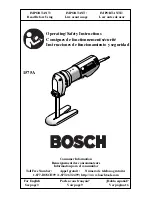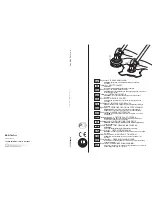
5
• Never start the foam cutter with the blades
in contact with the workpiece.
• Do not remove the foam cutter from the
workpiece while the blades are moving.
• Never put the foam cutter down until the
motor and blades have come to a complete
standstill.
• Never touch the blades during use.
• Make sure the material being cut is secured
properly.
WARNING!
Some dust created by power
sanding, sawing, grinding, drilling, and other
construction activities contains chemicals
known to cause
cancer, birth defects or other reproductive harm.
Some examples of these
chemicals are:
• Lead from lead-based paints,
• Crystalline silica from bricks and cement and
other masonry products, and
• Arsenic and chromium from chemically treated
lumber.
Your risk from these exposures varies, depend-
ing on how often you do this type of work. To
reduce your exposure to these chemicals: work
in a well ventilated area, and work with
ap-
proved safety equipment, such as those dust
masks that are specially designed to filter out
microscopic particles.
Double Insulated Tools
• Double Insulation
is a design concept
used in electric power tools which eliminates
the need for the three wire grounded power cord
and grounded power supply system. It is a
recognized and approved system by
Underwriter’s Laboratories, CSA and Federal
OSHA authorities.
IMPORTANT:
Servicing of a tool with
double insulation requires care and knowledge
of the system and should be performed only by
a qualified service technician.
WHEN SER-
VICE IS REQUIRED USE ONLY IDENTI-
CAL REPLACEMENT PARTS.
POLARIZED PLUGS: If your tool is equipped
with a polarized plug (one blade is wider than
the other), this plug will fit in a polarized outlet
only one way. If the plug does not fit fully in the
outlet, reverse the plug. If it still does not fit,
contact a qualified electrician to install the
proper outlet. To reduce the risk of electric
shock do not change the plug in any way.
Extension Cords
• Replace damaged cords immediately. Use of
damaged cords can shock, burn or electrocute.
• If an extension cord is necessary, a cord with
adequate size conductors should be used to
prevent excessive voltage drop, loss of power
or overheating. The table below shows the
correct size to use, depending on cord length
and amperage rating on the tool’s nameplate. If
in doubt, use the next heavier gauge. Always
Cord Length
"SAVE THESE INSTRUCTIONS"
Operating the Tool
Paddle Switch with “Lock-ON” feature
The Paddle Switch enables the operator to con-
trol the switch functions of “ON/OFF” and
“Lock-ON”.
TO SWITCH TOOL “ON”: Squeeze and hold
the paddle lever.
TO SWITCH TOOL “OFF”: Release pressure
on the paddle lever. The switch is spring loaded
and will return to “OFF” position automati-
cally.
The “Lock-ON” feature, incorporated into the
paddle switch, is a convenience for long opera-
tions.
TO LOCK SWITCH “ON”: After switch has
been activated, PULL the front portion of the
paddle lever completely BACKWARD and
release pressure on the paddle lever.
TO SWITCH TOOL “OFF”: Squeeze the rear
portion of paddle lever and then release the
paddle lever. The switch is spring loaded and
will return to “OFF” position automatically.
use U.L. and CSA listed extension cords.
Ampere Rating (shown on nameplate)
0-
2.1-
3.5-
5.1-
7.1-
12.1-
2.0
3.4
5.0
7.0
12.0
16.0
25'
18
18
18
18
16
14
50'
18
18
16
16
14
12
75'
18
18
16
14
12
10
100'
18
16
14
12
10
150'
16
14
12
12 Wire Gauge
Note: The smaller the gauge number, the larger
the wire is in the cord.
Summary of Contents for 1575A
Page 2: ...2 1 2 3 4 9 5 6 7 8 10 ...
Page 23: ...Notes ...






































